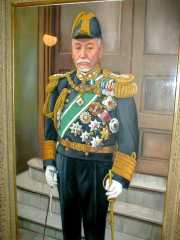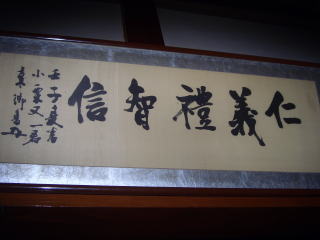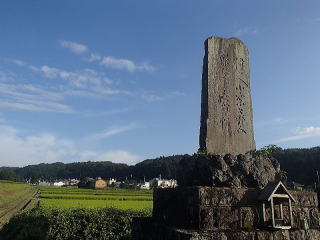| 何をしても正しい軍隊はない 「勝てば官軍」は権力者のおごり No army is right at any cost. "Might is Right" is the Arrogance of the Power. |
|
|---|---|
|
Acknowledgement by Heihachiro Togo ◆ "This shipyard was started by Kozukenosuke Oguri at the end of the Edo period after overcoming great hardships and has been in operation up to now..." In 1915 or Taisho 4, at the 50th anniversary of the Yokosuka Naval Arsenal, (a substitute for) Shigenobu Okuma surprised the attendees by saying the above. They were surprised because they thought that the Meiji government had built it. The construction of the shipyard began in 1865, the first year of Keio, at the end of the Edo period, and the facilities were gradually completed during the Keio years, with full-scale shipbuilding and manufacturing operations starting around 1867 Keio 3 as a comprehensive manufacturing plant. After the Meiji Restoration, it was taken over by the Meiji government along with the unpaid construction costs for the fourth year. However, the government used the shipyard silently without talking about such circumstances, so it is not surprising that people thought so. Ayako, Okuma's wife, is a cousin of Mrs. Michiko Oguri, the wife of Kozukenosuke
Oguri. This greeting came about because Okuma, who was serving as prime
minister of Japan at the time, was having a hard time raising the unpaid
money for the construction of the shipyard, which had been taken over by
the Meiji government. This greeting led the city of Yokosuka to create
busts of Oguri and the French chief engineer, Francois Leonce Verny, as
benefactors through fund-raising. |
|
  ▲小栗家の遺族に礼を述べた東郷平八郎 ▲書額 「仁義礼智信 (記念艦三笠にて・横須賀市) 壬子夏為 小栗又一君 東郷書」東善寺蔵 Heihachiro Togo who thanked Oguri's bereaved family (A Frame At the Mikasa Historic Memorial Warship, Yokosuka City) |
|
|
When they were shown into the room, they were told to sit at the seats of honor. When Sadao declined, Togo told him, "You are here in place of Kozukenosuke-san," and forced them to sit on the top seats. Togo said, "We were able to achieve complete victory over the Russian fleet in the Battle of the Sea of Japan thanks to your father, Kozukenosuke, who built the Yokosuka Shipyard. I wanted to express my gratitude to you," and offered them a meal. Afterwards, he wrote a calligraphy of "Jin, Gi, Rei, Chi, Shin (benevolence, justice, gratitude, cleverness, faith)" and presented it to them as a commemorative gift. Since there are no photographs of the meeting between Togo and Oguri's bereaved family, this calligraphy is valuable evidence that Togo thanked Oguri's bereaved family. On the occasion of the 130th anniversary of the Oguri Festival in 1997, the calligraphy was donated to Tozenji Temple by his great-grandson Tadato Oguri, who said, "The best way to restore my great-grandfather's honor is to see this." The great-grandson's words express his feeling that "the honor of my great-grandfather, Tadamasa Oguri, has not yet been restored."
◆ふつう「官」の反対語は → 「民」である。ところが日本語はおかしなことに Painstaking efforts to erect a cenotaph in honor of Kozukenosuke Oguri ◆ In 1929, a plan was submitted to the Takasaki Police Station to erect a monument on the riverbank where Oguri was killed, funded by the villagers who mourned his innocent death. At that time, the Japanese government did not allow freedom of expression for fear of criticism of the Meiji government, so such a monument could not be erected unless permission was obtained from the Ministry of Home Affairs. The contact point for the Ministry of Home Affairs was the police department. Soon after, the chief of the Takasaki Police Department called Motokichi Ichikawa, the former mayor of Gonda Village, who was in charge of erecting the monument. The chief told him the following: "The inscription says that the great Kozukenosuke Oguri was killed here without any crime, but it was the government forces that killed him. The government forces were the army of the Emperor, so they would not have cut down an innocent man. Therefore, it is not gentle to say, "He was slain...without sin, so do something about it." "Government Forces" is a bad word. ◆Normally, the opposite of "government" is "civilian." However, the opposite of "government forces" is not called "civilian forces" but "rebel forces," especially after the Meiji Restoration. "Rebel forces" means... forces made up of people who are bad at whatever they do. Then, "government forces" can mean... forces made up of people who are right at whatever they do.
...I wonder if there have ever been any forces in the world that are right no matter what they do and I think there will never be such forces in the future. However, since the Meiji era, "government forces consciousness" has been strong in Japan, and the politics of expelling foreigners and government forces consciousness have been rampant not only towards the people of Japan but also towards foreign countries until the defeat in WWII in 1945. The words of the Takasaki Police Chief were also spoken with the "government forces consciousness." |
|
顕彰けんしょう慰霊いれい碑  ▲顕彰慰霊碑(倉渕町水沼河原) 偉人いじん小栗上野介 罪なくして此所ここに斬らる 岳南 蜷川新 Cenotaph in honor of Kozukenosuke Oguri (Mizunuma Kawara, Kurabuchi Town) |
|
|
◆ 困った市川元吉元村長は村へ戻ると、碑文を書いた国際法学者蜷川新博士に手紙で報告し相談した。蜷川の母はつ子は小栗上野介夫人道子の妹で、元旗本の家に生まれた蜷川は苦学して国際法を学び国際法学者として同志社大学、駒沢大学で教え、総理大臣田中義一の国際問題顧問をつとめていた。そして昭和初年に著書『維新前後の政争と小栗上野の死』で上野介の無実の死を書き、明治政府の処置を厳しく糾弾していた。 |
|
| 関連ページ ◆横須賀製鉄所の借款説〈小栗上野介の濡れ衣〉 ◆官軍意識との戦い ◆お殿様のお首級(くび)迎え…小栗上野介父子の首級を盗掘した村人 |
関連ページ ◆ The theory that the Yokosuka ironworks were built with borrowed money (The false accusations against Kozukenosuke Oguri) ◆ The Battle Against Government Consciousness ◆ Welcoming Oguri's head to Tozenji Temple: Gonda villagers stole and retrieved the heads of Kozukenosuke Oguri and his son. |